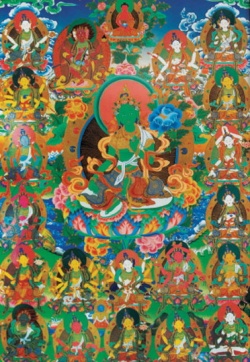Moving Out of the Dark Age
by Sakyong Mipham
According to many wisdom traditions, we are in a dark age. Over a thousand years ago, Padmasambhava, the great teacher who brought Buddhism from India to Tibet, predicted that this particular dark age would be distinguished by our increasing cleverness. We would create myriad ways to keep ourselves entertained, becoming experts in how to spend free time. We would use our intellect not for betterment but for hanging out in one form of distraction or another, constantly on holiday. Our discursive minds would run rampant. Padmasambhava predicted that as we became more shrewd and clever, compassion would seem increasingly futile, and we would forget how to bring meaning to our lives.
In the Shambhala teachings, we call this dark age the setting sun. The Tibetan word for “setting sun” literally means the dregs, the remains of the day. “Remains” is referring to the last remnants of virtue, in Tibetan gewa, which is positive activity that takes us forward, opening our hearts and minds rather than shutting them down. Actions like compassion and loving-kindness lead to happiness because they uplift our being. In a time when virtue is not valued, turmoil and negativity thicken our minds, causing confusion and unhappiness. We don’t have a clear understanding of our purpose or potential. When the activity that enables us to move forward to enlightenment is on the wane, our life-force energy is low. If we do not really understand where things are going or what the journey is—if we do not have a map, so to speak—we lose energy by spinning in circles, not practicing properly in the right direction.
What keeps us from moving forward? What is it that we need to overcome? First of all, we must overcome ambition—trying to accomplish something. When our mind is trying to accomplish something, it’s because there is a sense of dissatisfaction, a lack of contentment. This kind of ambition is different from exertion and practicing correctly; it is the wheels that keep samsara going. We are not recognizing the openness of our own nature. Since we do not understand who we are, we keep going around in a circle. We feel that we are getting somewhere, but later we see that we have gotten nowhere. There is always a sense of gain and loss.
Ambition is a sign that we are trying to appease our suffering by thinking that something external will make us happy. Because that approach is ego-centered and aggressive, it will never appease the suffering, it will only fire it up. This kind of ambition is actually bewilderment, not knowing what to do and where to put our faith. We are putting our hope and ambition into all kinds of things, coming up empty-handed.
Meditation and postmeditation heighten our awareness of the qualities of a worthy object. That is why we do formal practice. When we have the courage to literally take our seat and work with our mind, we are cultivating lack of ambition in a positive sense: we can relax into who we are. Opening up our mind in this way gives us the insight to overcome aggression and increase compassion. When we put ambition into this enlightened context, it will actually materialize as something of value.
Another impediment to moving forward in a dark age is attachment to our family and friends. Such attachment only creates suffering for ourselves and those around us. Meditation helps us let go of our fixation on being caught in a karmic situation with others. Or course we want our family and friends to be happy, but a subtle residue of aggression or greed often accompanies our desire for things to go well. As practitioners, we learn to relate to our family and friends without holding on. We need to recognize that if we want our loved ones to be well, to practice well is the most beneficial thing we can do.
In Tibetan culture, when people are having family problems, getting married, or starting a new business, they even supplicate a lama to practice on their behalf. We might think that’s spiritual materialism, but conventionally speaking, what do we usually do at such a time? By getting mad or worrying, we try to manipulate the situation in order to get what we want. Not only is that approach ineffective, it gets us even more entangled in attachment. If we’re going to be attached, it’s better to be attached to the beneficial power of practice.
Fear is another factor that keeps us in a dark age. That fear stems from a lack of trust in our genuine being, which naturally radiates compassion and kindness. Fear comes from ignorance of who we are. If we dwell in ignorance, we start thinking that “me” is a solid entity, that we need to reinforce ourselves, and that there are things to gain and lose. This leads to less compassion and more ambition and attachment.
Depression also drains our life-force energy. Somehow we cannot get our energy up. Depression is another sign of doubt in the potency of our own being. It also has a quality of claustrophobia—we are comfortable within the small domain of limiting concepts. I’m not necessarily talking about clinical depression, but about the depression of our ability to perceive the world as it is. We have padded our perceptions. When we do this, how we engage in the world strengthens our disbelief of our own nature, almost as if radar goes out and bounces back. We feel the room as small and the world as dead, so we can’t appreciate who or where we are.
When we’re depressed, we don’t want to extend ourselves, so we become lazy. Laziness and depression make a nice couple at the party of suffering. There’s a low-grade anger involved, a slight irritation at the sight of others celebrating. We want what they have. We can liberate that sense of heaviness and depression by relaxing in terms of how we regard our environment, not in a sloppy way, but by opening our senses. Appreciating where we are right now is a helpful antidote to depression.
Uplifting our minds and increasing our life-force energy begins with a good strategy. In this very difficult period, we need action-oriented practices, starting with mindfulness—paying attention. As practitioners, we have the power to create an uplifted environment that supports us in changing our habits. There is nothing like success, whether it is big or small, so we work with outmaneuvering the negativity by starting small. We begin by looking at the conditions of our life, which may be coming together in such a way that amplifies the darkness of the age.
In our daily cycle, where are we placing our mind? What environmental influences are we encouraging? When mindfulness shows us our options, we’ll be able to institute small changes that will have a cumulative effect. I call this the “ten-percent advantage.” If we shift our attention in just a few key ways, it’s easy to fall into negativity. If we shift our attention in other key ways, it’s easy to go in a positive direction. Paying attention to our life and arranging our environment so that it supports us in cultivating compassion is how we move out of the dark age with expediency and momentum.
How to Live a Life of Peace
The world is becoming ever more crowded, speedy, anxious, and intense. Under such conditions, our tendency is to become less compassionate, more aggressive, and more prideful. I feel that cultivating peace is the only way that the human race is going to survive.
How do we live a life of peace? By first discovering our peaceful nature. In “peacefully abiding,” or shamatha meditation, we train in continually bringing our focus back to an object such as the breath. We learn to gather the mind at deeper and deeper levels in order to relax in its innate peace, which manifests as stability, clarity, and strength.
Peaceful abiding meditation is not escapism; it is realism. Only the foolish think that they can find salvation outside themselves. When beings don't trust their own nature, they become agitated. That turns into blaming others, which becomes vengeance and destruction. Even if we destroy something, in the end we are just left with our own mind. The path of peace is one of exertion and diligence in working with the mind.
It is said that our minds are inherently scattered in six ways, because each of the six sense perceptions—sight, sound, smell, taste, touch, and mind—has its own consciousness. On top of that, fantasies and fears scatter our mind so far beyond our sense perceptions that it takes consistent practice to bring it back and place it on the breath.
Shamatha meditation gives us the skillful means to handle our mind. It’s as if we were training a wild horse. The first step is to develop some rapport with where we are right now. If we just sit down and grab the mind, it’s going to fight back. So we shouldn’t just blaze in and throw on the shamatha technique like a saddle on an untamed horse. First developing the quality of self-awareness—knowing who we are and what we’re doing—is very important.
So when we sit down on the cushion to meditate, we start by taking a look at what is happening in our life, which is the outer circle of our practice. Shamatha in everyday life is a feeling of things working, of orderliness, fluidity, and an absence of conflict. Without some degree of peaceful abiding in our daily life, there is always going to be struggle going on. That struggle might even keep us from going deeper in our meditation.
The next circle of shamatha is self-reflection. This is the first stage of formal practice. We begin by reflecting on how we’re feeling. We might ask, “Do I feel happy or sad? Do I feel anxious? What was my basic state of mind before I began to practice?” When we have emotional difficulties, it is often because we haven’t been paying attention to who we are. We might think we’re great practitioners, when in reality the same old neuroses are playing over and over in our minds. If we want to know the subtleties of the mind or hold an object of observation, we should at least be able to figure out how we feel.
Self-reflection can involve thinking as well. As meditators, we often have a puritanical view that thinking is bad. The reality is that we’ll sit on the cushion and think anyway. Why not think about something that will help us move in the right direction? “Now is my opportunity to train my mind. I have twenty minutes, and I am going to engage my mind and try to train it, just like working with a horse.”
Even after we’ve settled down and begun to place our mind on the breath, our mind can still be pretty wild. We have fantasies of surfing or eating lunch. Or we become fixated on anger or desire, and our emotions seem as solid as rocks. Fantasies and emotions are large thoughts that have the power to carry us far away, and getting to know them is part of the process of slowing down. But if we space out and let our mind roam, we aren’t really meditating, because we aren’t working with our mind at all. We’re just giving more oats to the horse and letting it run around, thinking that will make it tamer.
We have to watch how we handle ourselves. This is another level of self-awareness—being aware of how we’re meditating. Then when we notice that we’ve been swept away, that time hasn’t gone to waste, because as we note the patterns of movement, that allows us to recognize them more readily.
At this level we also see a lot of neutral thoughts. These can be the most dangerous to our meditation. Because they don’t consume us the same way as passion or aggression, we grow accustomed to them. We think, “It’s not that bad; I’m not spacing out that much.” That’s like saying, “My house is not exactly clean, but it’s good enough.” We don’t want to expend the extra energy, so we get used to living with a certain amount of dirt.
Then there are our discursive thoughts, which manifest as agitation, or a stream of chatter. In working with discursiveness, it’s important not to think, “My mind is really wild, I have a lot of thoughts, and therefore I’m a bad person.” We have to be aware of what’s going on in our discursive thoughts, and we shouldn’t try to get rid of them all. If we approach meditation too tightly, trying to be one-pointed at all times, we expend so much effort that we immediately rebound into even more discursiveness.
Instead, we practice watching the mind and seeing how it goes everywhere. It’s scattered and can’t settle or be happy with just one thought; it continuously brings things in. Of course, there will always be a certain amount of discursiveness. You can actually have a pretty good meditation session, say, for half an hour, having dribbles of discursive thought but never really losing the object of meditation.
One aspect of knowing where we are is that we can keep our expectations reasonable. If we say, “I’ve had a busy day. I’m totally wild, but now I’m going to sit down and stay right on the breath,” it’s not going to happen. Instead, we use our intelligence: “If I can simply feel the environment of the room and have a sense of my breath for half an hour, that will be a step forward.” Later, when we are a little calmer, we might think, “Now I can be a little more focused on my breath.”
The next level of thought we encounter is very subtle. These subtle thoughts are not fantasies that are taking us out to the newest restaurant or planning our next workout; they aren’t discursive thoughts creating mental buzz; they are just bubbly little thoughts. The mind percolates; that’s just the way mind is. But after we’ve practiced shamatha for a while, we might reach the stage where our mind is so stabilized in its own peace that these little thoughts dissolve like snowflakes in the sun.
My idea of success in meditation is longevity and consistency. We can meditate for a day and have a completely one-pointed experience, but that doesn’t mean that we’ve tamed our mind. The way we stick with meditation is to understand who we are, what we’re doing, and why we’re doing it. The mind is a wondrous thing. Happy and sad, all our feelings come forth from this mind. And as we feel all those things, we should try to relax. When we relax, we can feel our inherent purity, which gives us strength, love, and compassion.
The first article mentioned above. It has a very good explanation on depression. I feel that many people are going into depression and in general losing the zest or appreciation of life esp the younger generation and it may become an increasing trend.... SM Rinpoche gave a very clear explanation about this.
In connection with the Shambhala teachings, it is very important to raise one's wind-horse (lungta) and connect with the dralhas in one's life both on the relative and ultimate level and meditation is one way to bring us back to this.
Many city-people, from my own observation too, have this depleting problem. It is a matter of degree and whether it has deterioriated to a level low enough to cause alarm. I myself have suffered from it. I think it will help if people can pay attention to this area.
The depression is not part of you, it can be lifted, and life is not dreary. This perception is very changeable. Life can be rich, fulfilling and vibrant!
One very clear sign is when one feel that one's life is very hollow, not rich and joyful. Waking up every morning is like a chore, one doesn't feel like facing the world etc. It is a continual downward spiral of hopelessness and giving up-ness. If you consider our living conditions, compared with the very poor countries, we have many of the very much better conditions, but yet, some of us are feeling much worse than many of them.





